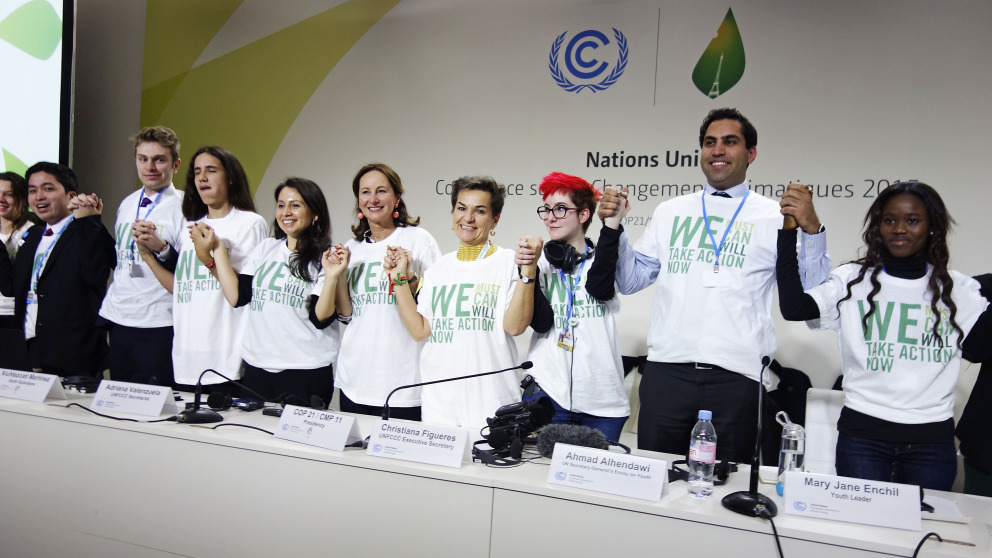Making Space for Visionary Thinking? How Civil Society Organizations Shaped the UN Sustainable Development Goals
17.03.2021
The development of the United Nations' Sustainable Development Goals (SDGs) was supposed to be more inclusive, transparent and participatory than previous processes, and to this end, civil society organizations were explicitly involved in the process. In a new study, IASS researchers Henrike Knappe and Oscar Schmidt analyse the engagement of these organizations and the visions of a better future that guided their contributions.

"The SDGs were formulated in September 2015 in consultation with nine so-called 'Major Groups', which were convened by the UN to represent different civil society groups, such as indigenous people, women or trade unions. Many other stakeholders also participated in this innovative process, which opened up the UN system. Our aim was to look beyond the formal architecture of the process and shed light on the actual actions and influence of civil society actors," explains political scientist Henrike Knappe. Together with agricultural scientist Oscar Schmidt, Knappe found that the Major Groups took on the role of visionaries and supervisors to the state representatives. Their actual impact on the elaboration of the SDGs varied, however.
Young people's visions of the future went unheard
The IASS researchers took a closer look at two major groups: children and young people, and farmers. Knappe and Schmidt investigated the diversity of representations of the future – including stories, scenarios, and visions – within these two groups as well as the relationship between these aesthetic representations of futures and the elaboration of political goals. Both groups claimed to represent the broader aspirations and wishes of their respective major group. The children and young people, for example, defined themselves as the group that can pave the way towards a better, more sustainable future, while also positioning themselves as victims facing a range of existential threats.
They adopted the perspective of a future world that reconciled people and planet in order to spur decision-makers to action. Speaking from this future-oriented standpoint, they articulated representative claims of an often visionary quality. The vulnerability of this position and its susceptibility to contestation is highlighted by the fact that this group failed to achieve one of its concrete goals, namely the establishment of a United Nations High Commission for Future Generations.
Farmers' demands for higher incomes meet with success
The farmers, on the other hand, situated their claims in the present and looked forward into the future from this standpoint. Their vision of the future was very clear and grounded in the claim of an existential link between the interests of farmers, the survival of the planet, and the existence of a future at all. Ultimately, their demands for higher agricultural incomes, lower trade barriers, and investment and technical support for agricultural producers in the Global South became core elements of the second sustainable development goal – "Zero hunger". In doing so, they succeeded in anchoring their demands in the outcome of the SDG negotiations.
Neither of the groups engaged substantially with representatives of the UN member states who were primarily responsible for drafting the SDGs. The two groups frequently expressed themselves in a manner that was cautious or vague, and their communications were often directed at a single forum. Both groups expended considerable time and energy in justifying their demands. Making their claims from a less secure position, both groups appear to have felt the need to reassure audiences that they enjoyed the backing of stakeholders as legitimate representatives. They also found it problematic that they were largely sidelined during the actual negotiations despite being invited to contribute to the development process. Representatives of both groups called repeatedly for this deficit to be addressed.
New strategies needed to tackle uncertain futures
United Nations' processes could well be improved in this regard, the researchers confirmed. "Achieving these changes will require a broader and more comprehensive examination of how democratic governance can engage with open and uncertain futures in order to allow for more diverse representations of the future in global environmental governance," explains Knappe. The inclusion of more radical and transformative futures in United Nations negotiation spaces presents new challenges, but could result in global policy goals that many more people will embrace.
Knappe, H., Schmidt, O., Making Representations: The SDG Process and Major Groups’ Images of the Future,Global Environmental Politics 1–21. https://doi.org/10.1162/glep_a_00599
Contact
